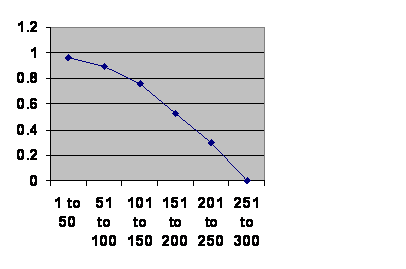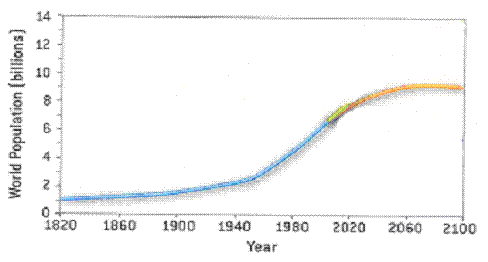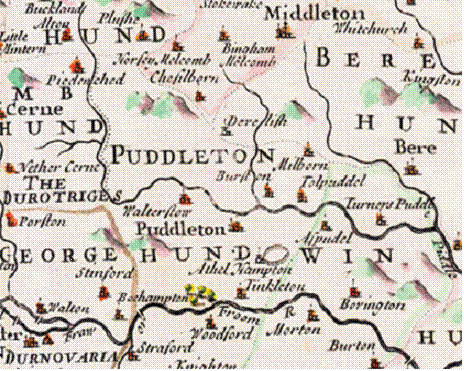The Melbourne poster:
This is a rough copy of a poster presented at the International Congress on Genetics in Melbourne Australia in 2003.
History of southern Mesopotamia
Rounding to the nearest 5 years, the early dynastic period lasts 200 years, Sumer 250, Akkadian 150, from the end of the Akkadian to the Gutien invasions 75, Gutien invasions to Ur 155, Ur 120, Isin-Larsa period 100, Old Babylon 300, Kassite 140, Hittite 180, Middle Assyrian 185, Chaldean 175, Late Assyrian 290, New Babylonian 60, Persian 210, Alexander the Great's empire 30, Selucid 240, Roman 190, Parthian 210, Sassanid 280, Ulmayad 120, Abbasid 200, Bayid 110, Turk 170, Mongol 160, Tamerlanes's empire 120, Safavid 240, Ottoman Turk with drafted Janissaries160, and afterward for 220 years.

Using these numbers, we made a graph of the chance each civilization or empire had of surviving in Mesopotamia for each successive half century. If empires failed for extrinsic reasons, the line would be level. If for intrinsic reasons, the line would rise because of selection. The fall suggests some factor inherent in empire; we believe it is the birth rate of the rulers. The curve is defined by 3 numbers suggesting a simple universal scientific law. The older the empire, the more likely the collapse, probably because of a collapse of the birth rate of the elite, who would have a greater social horizon and thus a larger mating pool than the poor. Elsewhere, Egypt, Greece and Rome each broke this pattern, but for identifiable reasons: geography, seclusion of women and recruiting new populations.
World Growth Rate

Information from The Climax of Humanity. George Musser SCIENTIFIC AMERICAN 293: 3 44 September 2005.
World population growth peaked in about 2,000. This article offers three projections, each defined by 3 values, suggesting a simple universal scientific law. By the middle projection, it should level off at about 2060, or 2 generations from now. Assuming that rapid growth began about 1940, that is 2 generations from the beginning of rapid growth to inflection point, 2 from inflection point to peak, assuming a symmetrical curve, 2 generations from peak to half way down and 2 to zero births. Add another 60 years for the youngest people to reach the end of their greatest vigor, and the entire time is 300 years from the beginning of rapid growth to collapse of society. That coincides unreasonably well with the Mesopotamian experience of maximum 300 years from the beginning of an empire to its collapse.

Europe’s Birth Rates Cradle Snatching: The Difficulties of Living with a Low Birth Rate. ECONOMIST 378: 8469 55 18 March 2006.
By and large, the great western powers have seen their birth rates drop by something less than half over 45 years. That is consistent with fully half lost over 60 years, and is consistent with the experience for the contemporary world as well as ancient Mesopotamia. Europe is simply farther ahead on the curve than the rest of the world. The birth rate in Europe would be expected to fall to about zero in about two more generations, so unless there is a drastic change, we may be watching the last generation of fertile Europeans being born. They will be having their final children about the time the last fertile humans are being born.
Russian Birth Rate
At a state of the nation address, (Playing a Dangerous Game ECONOMIST 378: 8477 59 13 May 2006) President Vladamir Putin was coy while the world waited for news on such issues as xenophobia, as whether Russia would continue to supply gas to Western nations for cash and not ask for anything else as well, as assuming the ministerial presidency of the Council of Europe, as relations with Georgia, Poland and the Ukraine, as Dick Cheney’s critical speech in Vilnius, as an arms race. All Putin was worried about was the declining birth rate. Like Caesar Augustus, he is a man in charge of a super power without babies. Under Stalin, the communists not only had murdered tens of millions, they had also forced an enormous number of people to move, thus disrupting any local village structure. This may have left Russia particularly vulnerable to infertility from excess population size.
The Domesday Book Experience

Part of a map of Dorset published in 1695. A “hund” is a hundred “hides” (enough land to support a family) and measures about 6 miles across. From center to edge is about an hour’s walk with a two-way cost of 6 hundred kilocalories. That would be about the limit of a young person’s social horizon. The villages are actually smaller than hunds, but probably not air tight. About a hundred families might make up a social pool. The Domesday Book chronicled thousands of villages shortly after 1066. Essentially all are still there after more than 30 generations.
The Magna Charta
500 barons owned all the land and all the villages recorded in the Doomsday Book. They forced the king to sign the Magna Charta, the first code of law actually put together by the people who were going to have to live under it. They intended to control and have their heirs control that land until doomsday, and they had the clout to see to it that the law was designed to give them their best chance to do just that. But all of those families have died out. Of course they must at one time have numbered more than 500 nuclear families as multiple sons would not have been rare. Their history was meticulously recorded by the College of Heralds. It was one occasion that might have proven that 500 families can last as long as 100. Instead it seems to have proven just the opposite. (Note: By August 3, 2008 we had more information. It turned out that the Barons who signed the Magna Charta did very well from a reproductive standpoint, thank you.)
In any generation, each family has a statistical chance of producing no son. But the rules of primogeniture specify that if there are no sons, the land goes to an uncle or a cousin until every possibility in the direct male line has been exhausted. Statistically, some families should have had fewer than average, but some should have more than average. 500 should not go extinct for that reason, and famine and plague should have been as hard on the peasants as on the aristocracy.
Haldane’s Law
Sex is determined by sex chromosomes. Each species has 2 kinds. One sex will have two of the same kind, and the other sex will have one of those and a different one. In mammals and fruit flies, the female has two of the same chromosomes and the male one of each. In birds it is the opposite. Haldane’s law states that when hybrid infertility occurs, it is the sex that has the two different chromosomes that is more affected. In mammals, that means that males will be more vulnerable to hybrid infertility than females.
We propose that Haldane’s law can be generalized. We propose that excess genetic diversity can depress fertility whether it occurs because of a single cross between two incompatible lines or multiple crosses between lines, any two of which could have fertile offspring. In either case, the same sex should be affected.
This hypothesis results in a prediction: by the time the birth rate of a population begins to decline from excess genetic diversity, there will be evident loss of male development. We should predict lower sperm count, reduced sperm mobility, more frequent deformed sperm, smaller penis sizes and increased incidence of hypospadias and other development abnormalities of the male genital system.
Genealogies
If, indeed, an excessively large population will suffer a loss of fertility, it should be possible to see the effect given a sufficiently extensive and complete genealogy. Every living human being has had at least some consanguinity among his ancestors in the last 1,000 years, simply because 30 generations ago there were not 1,000,000,000 people in the world. It should be possible to establish a consanguinity index for everybody within a sufficiently detailed genealogy. The genealogy would also provide the number of offspring. There should be a correlation between consanguinity and fertility, which should hold up despite controlling for other factors, such as economic and social pressure. Possible helpful genealogies might be found in Iceland, with the US census bureau, with the British College of Heralds or with the Church of Latter Day Saints.
There have been 302 visitors so far.
Home page.



